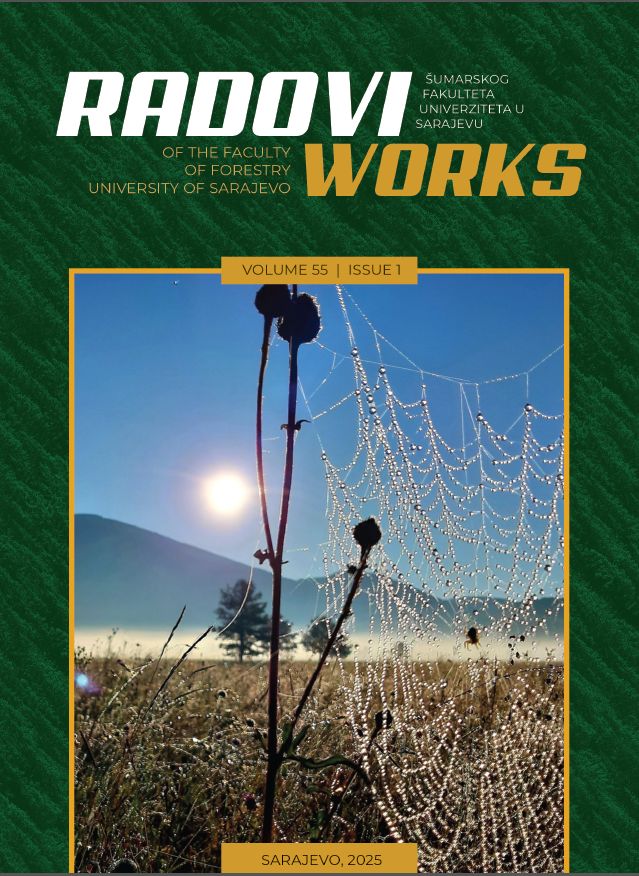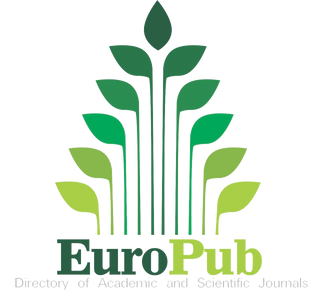Ocjena kvaliteta i zdravstvenog stanja urbanog zelenila u kampusu Univerziteta u Sarajevu i ulici Zmaja od bosne
DOI:
https://doi.org/10.54652/rsf.2025.v55.i1.601Ključne riječi:
urban greenery, tree health status, wood decay, maintenance measures, mechanical damageSažetak
This paper analyzes the health status of urban trees in the Campus area of the University of Sarajevo, with a particular focus on wood decay, mechanical damage, and the impact of maintenance practices. A total of 507 trees were evaluated for taxonomic composition, vitality decline symptoms, presence of pests, and the need for maintenance interventions. The results showed a statistically significant correlation between decay and damage to the root collar and major trunk injuries. Maintenance measures, especially pruning and soil loosening, had a positive effect on reducing symptoms of tree decline. Pests were also recorded, particularly on small-leaved linden and horse chestnut. The findings highlight the importance of regular monitoring, selection of resistant species, and an integrated approach to urban greenery management, especially in light of climate change and increasing urban stressors.
Downloads
References
Perrette, G., Yilmaz, E., & Pilleboue, E. (2021). A data-driven approach to urban tree maintenance: Predicting pruning activities from heterogeneous data. Urban Forestry & Urban Greening, 61, 127090.
Ow, L. F., Ghosh, S., & Sim, E. K. (2013). Tree pruning: A review on practices, physiological consequences, and effects on growth. Urban Forestry & Urban Greening, 12(4), 464–472.
Alvey, A. A. (2006). Promoting and preserving biodiversity in the urban forest. Urban Forestry & Urban Greening, 5(4), 195–201. https://doi.org/10.1016/j.ufug.2006.09.003
Johnson, G. R. (1999). Protecting trees from construction damage: A homeowner’s guide (FO-6135-S, revised). University of Minnesota Extension Service. Retrieved from http://www.extension.umn.edu/distribution/housingandclothing/DK6135.html
Dempsey, G. (1994). Notes from hurricane Andrew. In L. L. Burban & J. W. Andersen (Eds.), Storms over the urban forest (2nd ed., pp. 105–133). U.S. Department of Agriculture, Forest Service.
Bassuk, N., Trowbridge, P., & Atkinson, D. (2011). The effects of soil compaction on tree growth. Urban Forestry & Urban Greening, 10(5), 291–296.
Day, S. D., Wiseman, P. E., & Dickinson, S. B. (2010). Tree root growth in response to soil compaction. Journal of Environmental Horticulture, 28(2), 75–83.
Gilman, E. F. (2001). An illustrated guide to pruning (2nd ed.). Delmar Cengage Learning.
Kozlowski, T. T. (1999). Sap flow and water relations of trees. Tree Physiology, 19(10), 655–662.
Johnson, G. R., Hauer, R. J., & Pokorny, J. D. (1992). Prevention of hazardous tree defects. In Urban tree risk management: A community guide to program design and implementation (Chap. 4). USDA Forest Service.
Hoyle, H., Hitchmough, J., & Jorgensen, A. (2017). All about the 'wow factor'? The relationships between aesthetics, restorative effect and perceived biodiversity in designed urban planting. Landscape and Urban Planning, 164, 109–123.
Anselmi, N., Saraceni, A., & Anselmi, A. (2021). Incidence of Armillaria species in agrarian, forest and ornamental ecosystems of the Lazio region. Agriculture and Forestry, 67(1), 7–25.
Augustinus, B. A., Abegg, M., Queloz, V., & Brockerhoff, E. (2024). Higher tree species richness and diversity in urban areas than in forests: Implications for host availability for invasive tree pests and pathogens. Landscape and Urban Planning, 250, 105144. https://doi.org/10.1016/j.landurbplan.2024.105144
Barona, C. O., Sabetski, V., Millward, A., & Steenberg, J. (2018). De-icing salt contamination reduces urban tree performance in structural soil cells. Environmental Pollution, 234, 562–571. https://doi.org/10.1016/j.envpol.2017.11.101
Bartesaghi Koc, C., Osmond, P., & Peters, A. (2017). Towards a comprehensive green infrastructure typology: A systematic review of approaches, methods and typologies. Urban Ecosystems, 20, 15–35.
Bettinger, P., & Kellogg, L. D. (1993). Residual stand damage from cut-to-length thinning of second-growth timber in the Cascade Range of Western Oregon. Forest Products Journal, 43(11/12), 59–64.
Brockerhoff, E., & Liebhold, A. (2017). Ecology of forest insect invasions. Biological Invasions, 19. https://doi.org/10.1007/s10530-017-1514-1
Chen, W. Y., & Jim, C. Y. (2008). Assessment and valuation of the ecosystem services provided by urban forests. In M. M. Carreiro, Y. C. Song, & J. Wu (Eds.), Ecology, Planning, and Management of Urban Forests (pp. 53–83). Springer. https://doi.org/10.1007/978-0-387-71425-7_5
Dautbašić, M., Spasojević, B., & Mujezinović, O. (2016). Dendroflora urbanog zelenila grada Mostara i njena zaštita. Sarajevo: Šumarski fakultet Univerziteta u Sarajevu.
Donovan, G. H. (2017). Including public-health benefits of trees in urban forestry decision making. Urban Forestry & Urban Greening, 22, 120–123. https://doi.org/10.1016/j.ufug.2017.02.010
Escobedo, F. J., Kroeger, T., & Wagner, J. E. (2011). Urban forests and pollution mitigation: Analyzing ecosystem services and disservices. Environmental Pollution, 159, 2078–2087.
Feltynowski, M., Kronenberg, J., Bergier, T., Kabisch, N., Łaszkiewicz, E., & Strohbach, M. W. (2018). Challenges of urban green space management in the face of using inadequate data. Urban Forestry & Urban Greening, 31, 56–66. https://doi.org/10.1016/j.ufug.2017.12.003
Frank, S. D., & Just, M. G. (2020). Can cities activate sleeper species and predict future forest pests? A case study of scale insects. Insects, 11(3), 142. https://doi.org/10.3390/insects11030142
Gauthier, N., Fountain, E. W., & Missun, T. (2015). Tree wounds – Invitations to wood decay fungi. Plant Pathology Fact Sheet. University of Kentucky, Cooperative Extension Service.
Gubka, A., Zúbrik, M., Rell, S., Gareau, N., Goble, T., Nikolov, C., Galko, J., Vakula, J., Kunca, A., & Dejonge, R. (2020). The effectiveness of the neem product TreeAzin® in controlling Cameraria ohridella. European Journal of Entomology, 117, 463–473. https://doi.org/10.14411/eje.2020.049
Gupta, A., Mora, S., Preisler, Y., et al. (2024). Tools and methods for monitoring the health of the urban greenery. Nature Sustainability, 7, 536–544. https://doi.org/10.1038/s41893-024-01295-w
Hamzah, H., & Hasan, R. (2024). An examination of the risks of hazardous trees in the context of vandalism prevention in urban areas. Planning Malaysia, 22, 222–233. https://doi.org/10.21837/pm.v22i34.1625
Hasković, A. (2014). Istraživanje procesa truleži drveta na povrijeđenim stablima jele na Igmanu [Magistarski rad]. Univerzitet u Sarajevu, Šumarski fakultet.
Helja, A. (2015). Uticaj oštećenja korijena i debla na razvoj truleži drveta jele (Abies alba Mill.) [Magistarski rad]. Univerzitet u Sarajevu, Šumarski fakultet.
Hilbert, D. R., Roman, L. A., Koeser, A. K., Vogt, J., & van Doorn, N. S. (2019). Urban tree mortality: a literature review. Arboriculture & Urban Forestry, 45(4), 167–200.
IPCC. (2021). Summary for Policymakers. In R. P. Allan et al. (Eds.), Climate Change 2021: The Physical Science Basis. Cambridge University Press. https://doi.org/10.1017/9781009157896.001
Kimic, K., Mirzwa-Mróz, E., & Szyndel, M. (2022). Diagnosis and recommendations for management of trees and shrubs in green squares in Warsaw based on research on fungal diseases. Trees, 37, 1439–1451. https://doi.org/10.1007/s00468-022-02270-8
Krivosheina, M., & Ozerova, N. (2020). Horse-chestnut leaf miner Cameraria ohridella: Invasion history and prognosis. IOP Conference Series: Earth and Environmental Science, 579, 012071. https://doi.org/10.1088/1755-1315/579/1/012071
Krpan, A. P. B., Petres, S., & Ivanović, Ž. (1993). Neke fizičke štete u sastojini, posljedice i zaštita. Glasnik za šumske pokuse, posebno izdanje, 4, 271–280.
Livesley, S. J., McPherson, E. G., & Calfapietra, C. (2016). The urban forest and ecosystem services: Impacts on urban water, heat, and pollution cycles at the tree, street, and city scale. Journal of Environmental Quality, 45(1), 119–124. https://doi.org/10.2134/jeq2015.01.0056
Martinić, I. (1992). Interakcije metoda rada, radnih uvjeta i proizvodnosti rada pri sječi i izradi drva u proredama sastojina. Glasnik Šumarskih pokusa, 28, 133–178.
Matsiakh, I., & Menkis, A. (2023). An overview of Phytophthora species on woody plants in Sweden and other Nordic countries. Microorganisms, 11(5), 1309. https://doi.org/10.3390/microorganisms11051309
Morales-Gallegos, L., Martínez-Trinidad, T., Alvarado-Rosales, D., Saavedra, L., Hernández-de la Rosa, P., & Gomez-Guerrero, A. (2024). Incidence and severity of damage agents on established trees in urban green areas. Agrociencia, 58(6), 1–16. https://doi.org/10.47163/agrociencia.v58i6.3165
Nitoslawski, S. A., Galle, N. J., van den Bosch, C. C. K., & Steenberg, J. W. (2019). Smarter ecosystems for smarter cities? A review of trends, technologies, and turning points for smart urban forestry. Sustainable Cities and Society, 51, 101770.
Nowak, D. J., & Dwyer, J. F. (2007). Understanding the benefits and costs of urban forest ecosystems. In J. E. Kuser (Ed.), Urban and Community Forestry in the Northeast (pp. 11–25). Springer. https://doi.org/10.1007/978-1-4020-4289-8_2
Nowak, D. J., Greenfield, E. J., Hoehn, R. E., & Lapoint, E. (2013). Carbon storage and sequestration by trees in urban and community areas of the United States. Environmental Pollution, 178, 229–236.
Richardson, E., & Shackleton, C. M. (2014). The extent and perceptions of vandalism as a cause of street tree damage in small towns in the Eastern Cape, South Africa. Urban Forestry & Urban Greening, 13(3), 425–432. https://doi.org/10.1016/j.ufug.2014.04.003
Schlaepfer, M. A. (2018). Do non-native species contribute to biodiversity? PLoS Biology, 16(4), e2005568. https://doi.org/10.1371/journal.pbio.2005568
Schlaepfer, M. A., Guinaudeau, B. P., Martin, P., & Wyler, N. (2020). Quantifying the contributions of native and non-native trees to a city’s biodiversity and ecosystem services. Urban Forestry & Urban Greening, 56, 126861. https://doi.org/10.1016/j.ufug.2020.126861
Seth, M. K. (2003). Trees and their economic importance. Botanical Review, 69, 321–376. https://doi.org/10.1663/0006-8101(2004)069[0321:TATEI]2.0.CO;2
Smith, H. C., Miller, G. W., & Schuler, T. M. (1994). Closure of logging wounds after 10 years. USDA Forest Service Research Paper NE-692.
Stagoll, K., Lindenmayer, D. B., Knight, E., Fischer, J., & Manning, A. D. (2012). Large trees are keystone structures in urban parks. Conservation Letters, 5(2), 115–122. https://doi.org/10.1111/j.1755-263X.2011.00216.x
Świercz, A., & Zajecka, E. (2016). A contribution to the problem of tree necrosis in cities: Soil properties in the habitat of Ulmus glabra Huds. and Ulmus minor Mill. Greenery elements of the city of Kielce. Ochrona Środowiska i Zasobów Naturalnych, 27, 1–7. https://doi.org/10.1515/oszn-2016-0002
Tabassum, S., Manea, A., & Leishman, M. R. (2024). Limiting the impact of insect pests on urban trees under climate change. Urban Forestry & Urban Greening, 94, 128246. https://doi.org/10.1016/j.ufug.2024.128246
Werbin, Z. R., Heidari, L., Buckley, S., Brochu, P., Butler, L. J., Connolly, C., Bloemendaal, L. H., McCabe, T. D., Miller, T. K., & Hutyra, L. R. (2020). A tree-planting decision support tool for urban heat mitigation. PLoS ONE, 15(10), e0224959. https://doi.org/10.1371/journal.pone.0224959
Wong, N. H., Tan, C. L., Kolokotsa, D. D., & Takebayashi, H. (2021). Greenery as a mitigation and adaptation strategy to urban heat. Nature Reviews Earth & Environment, 2, 166–181.























